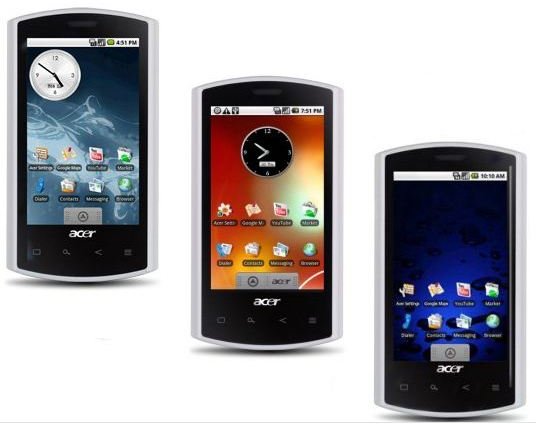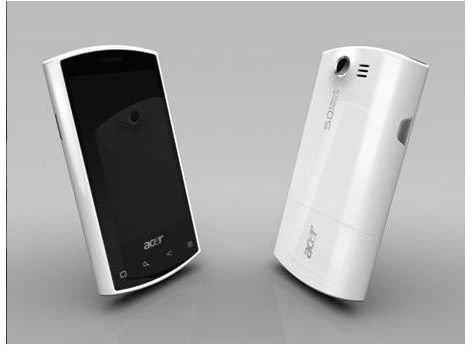Review of the Acer Liquid - Part 1: Introduction and Design
Introduction
The Acer Liquid is one of the first phones made by the company, and the first one to be carrying the Android mobile operating system. Its predecessor was the neoTouch which ran on Microsoft’s Windows Mobile. The phone was certainly unprepossessing with numerous deficiencies in the design. The Liquid is shaping up to be a different prospect altogether, even though Acer is new to the mobile handset market.
The phone is a touchscreen smartphone and therefore falls squarely into a certain bracket. It is an expensive device but the features are interesting too.
Design (5 out of 5)
The Acer Liquid is a substantial phone, measuring 115 by 62.5 by 12.5 mm. The screen, with a resolution of 800 x 480 pixels, accounts for a large part of the phone’s real estate, so the dimensions are not too surprising. It is quite a heavy phone though, weighing in at 135 gm.
The design is a winning combination of glossy black and white. The edges are smooth and rounded, keeping the overall appearance simple and classic. The 3.5 inch touchscreen dominates most of the front, in addition to four touch buttons alongside the bottom. The back is kept attractively plain, with the camera inset and a loudspeaker. The right edge has the volume rocker switch and the dedicated camera key while the left edge just has the power button.
The top edge is glossy with the 3.5 mm headphone jack in one corner. The rest of the space is used for status indicators, which is a charming and very useful design idea. The bottom is more prosaic with the miniUSB port covered with a dust protector, and maintaining the smooth flow of plastic.
The microSD card slot is under the battery cover, and the user would have to first extract the battery to gain access. It is a definite flaw in the design, as it would be better to have the ability to swap storage cards without having to remove the battery each time.
The phone comes in two variants: one black and white combination, and one fully glossy black. The white and black one looks different enough to have our vote.
Features (5 out of 5)

The contacts application is quite sophisticated, with a number of useful features. It is designed with ease of use kept in mind, and therefore, although each contact can have exhaustive details, adding those details is certainly not a chore. Contacts can be starred which is somewhat akin to speed dialling. They can also be placed as shortcuts on the homescreen, and if there is a contact image that image shows up as the shortcut icon. There is no smart dialling, which is a surprising lapse in the otherwise full-featured application.
The messaging application is organized into threads rather than folders, similar to Gmail. New messages appear at the bottom of the thread. The most recent communication threads for that contact are also moved up to the top of the stack, regardless of their place in the timeline. Of course, the Gmail integration works exceedingly well, with almost the same functionality as the web interface and other sophisticated email clients. Other email addresses can be configured easily enough, and the messages are stored the same way they are online. The other accounts do not have threaded messages.
Connectivity is certainly not a problem with the Acer Liquid, as it has Wi-Fi and Bluetooth capabilities. The phone supports multiple standards so international roaming is possible with the Liquid. There is GPS available for a fee, although Google Maps can be easily configured to do the same job.
The web browser is great, very responsive to touch controls. There is no pinch zooming, but the other intuitive controls work well. There appears to be no Flash support in the browser, which is perhaps its biggest flaw. Apart from that, the menus are easily navigable, the settings are highly customizable and the design is reminiscent of fully-fledged browsers on bigger devices.
The gallery is well designed, with links to each area that has stored multimedia. The links are shown as folders, mimicking the folders they are physically stored in. The folder icon displays a preview of the first few files in the folder, making it easy to identify the contents. The video gallery is somewhat limited in terms of organizational efficiency. The videos are stored in a flat list format, rather than organized into folders. It is not a big issue, but it would have been nice to have the option. There is also limited batch edit functionality in the gallery.
The music player is basic, with a rather simplistic interface. The files are accessed through four large buttons which each bring up music sorted by the artist, album, song or playlist. However, there is one redeeming feature which elevates the player from the mediocre and that is the ability to look up the playing song on YouTube from the player itself. The search results are then sent to the pre-loaded YouTube client for immediate viewing.
The Acer Liquid has a 5 megapixel camera, which is far from shabby. The interface is not designed well though. The camera application brings up a simple viewfinder with a few shortcuts alongside. Although the lack of clutter is appealing, access to the settings menu is cumbersome and buried under multiple layers. Additionally, although there is autofocus, there is no flash – therefore pictures in lowlight are out of the question.
There is a serviceable document viewer for easily viewing email attachments. However these cannot be saved to the phone under any circumstances, which makes it rather inconvenient. The documents cannot be edited either, until the user pays for the upgrade. All in all, the document management system is a disappointment.
User Interface (4 out of 5)
The Android OS powers the Liquid and, coupled with a powerful Snapdragon processor, it makes for a delightful user experience.
There is one homescreen, although it is about three times the size of the screen. The side panels can be accessed by scrolling to either side. It is fully customizable with a series of widgets, shortcuts to various galleries and folders. There are also Live Folders which are automatically populated with content, like a contact’s Twitter feed for example. The user is presented with two preloaded lists, although it can be customized to display practically anything. The Media player on one side of the homescreen displays the media items in an artistically messy stack. The user chooses which type of media they would like to be displayed, and accordingly the stack changes.
The Acer Liquid, like most Android phones, has a bar lining the top edge of the homescreen, displaying all the recent notifications. Tapping on the bar will open a drop-down menu displaying all notifications, regardless of which applications are currently open. This feature works nicely in conjunction with the LED notification lights on the top edge of the handset. In addition, tapping any notification results in an appropriate action, lfor example tapping a new message received notification will open that message in the messaging application.
There is no task manager to speak of, although Android does allow multi-tasking. The inactive apps are saved as they are on the hard disk, and not in main memory. When a user brings up an inactive app, the app data is loaded back into a new instance of that app. It is an ingenious way of saving on main memory, without having to compromise on the convenience of multi-tasking.
Performance (4 out of 5)
The capacitive touchscreen is very responsive, registering the gentlest brush as opposed to vigorous tapping. Scrolling through images and videos takes little time, and with no noticeable lag at all.
Audio output is quite good on the Acer Liquid, with very little background noise and disturbance. The sound is clear, whether when playing music or when using the loudspeaker for calls. However the output itself lacks volume.The Snapdragon processor helps matters a great deal, as each screen loads with hardly any lag whatsoever.
The Verdict (4 out of 5)
The Acer Liquid is a stylish phone with great styling and features. Most of its flaws are directly attributable to the Android mobile operating system, as the system was very much in its infancy when the phone was released. That being said, it is nevertheless a powerful smartphone.
One of the great advantages of having an Android phone is the access to innumerable developer apps. There is a dedicated app installed for Android Market, where users can browse the options for download easily. On the whole, the Liquid is a great handset, especially considering it is one of the first forays by Acer into the industry.
